There was a time when Blackberry’s name was enough to justify class and luxury. Yes, you heard it right. We are talking about the mobile brand, Blackberry.
Blackberry was first developed by a Canadian software company Research In Motion in 1984. They launched their first ever device named RIM 850 in 1999 which was used to send and receive emails. It was widely regarded as a wireless communication device at that time.
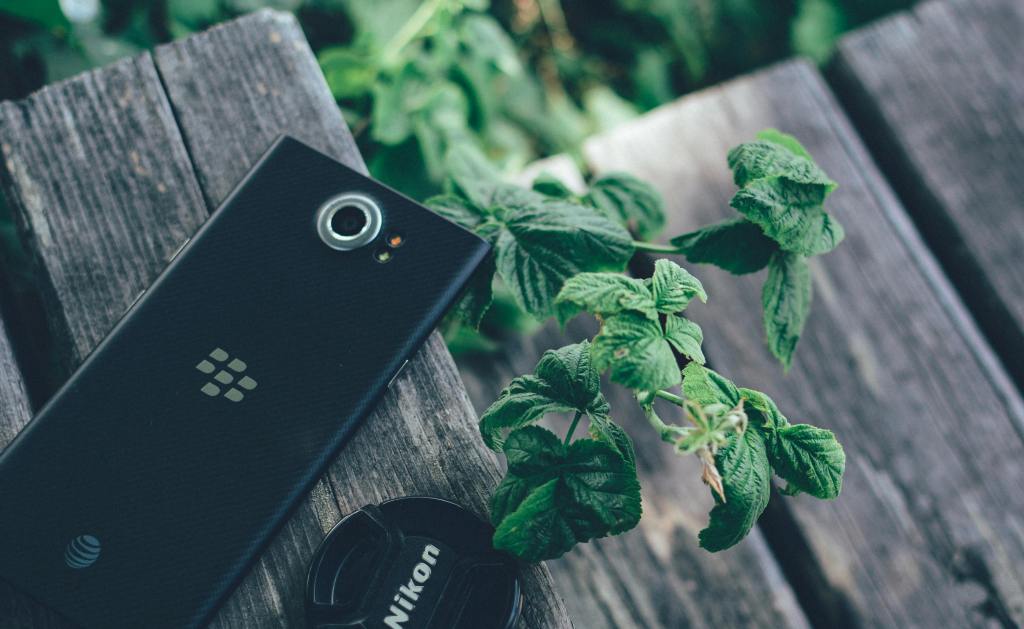
Peak BlackBerry: The King of Secure Communication
BlackBerry’s rise to fame began in 1999 with its iconic pagers and smartphones. These devices were known for their physical keyboards, a feature that offered superior typing compared to the early touchscreens of the time. But BlackBerry’s true strength was its focus on security. Their proprietary operating system and encrypted messaging service, BlackBerry Messenger (BBM), made them the go-to choice for businesses and governments demanding secure communication.
The Fall and Transformation
By the late 2000s, however, BlackBerry failed to adapt to the rapidly changing smartphone landscape. The rise of the iPhone and Android devices with their user-friendly touchscreens and app ecosystems proved too much to compete with. BlackBerry’s market share plummeted, and the company eventually stopped producing its smartphones in 2016.
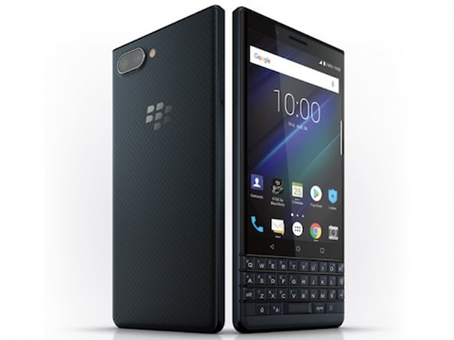
However, this wasn’t the end of the BlackBerry story. The company pivoted its focus to cybersecurity, leveraging its expertise in secure communication to offer software and services for businesses and governments. BlackBerry’s security solutions, powered by Artificial Intelligence, protect devices, networks, and data in today’s ever-increasingly connected world, known as the Internet of Things (IoT).
Market leader
The innovation of the qwerty keypad was approached by Blackberry first and their qwerty keypad model was the market giant at that time. Blackberry has been a class and luxury lifestyle this has become an iconic phone model among businessmen. In various movies and real life, blackberry has been a class for businessmen and businessmen. At that time, the European market, Asian Market, US market and all other market was led by Blackberry. The evolution starts from the 2000s and continue till 2010. Every kid from the 2000s dreamt about having a Blackberry phone in their life when they were mature enough.

Source: Blackberry SEC filings
As per the source of Blackberry SEC filings, the graph shows the drastic fall of Blackberry phones in the smartphone market. In 2003 the brand started to rise into the smartphone market and with their innovative approach, they led the market in top position. 2011 was the most successful year for Blackberry and they reached the figure of $20 bn in the smartphone market. After 2016, blackberry saw a drastic fall in 10 years and they never managed to rise in the position. As their peak time, Blackberry has managed to clock at record-breaking sales of 15 m phones per quarter. The best season for Blackberry was from 2009-2013. These five years saw the biggest sales of blackberries in the global market.
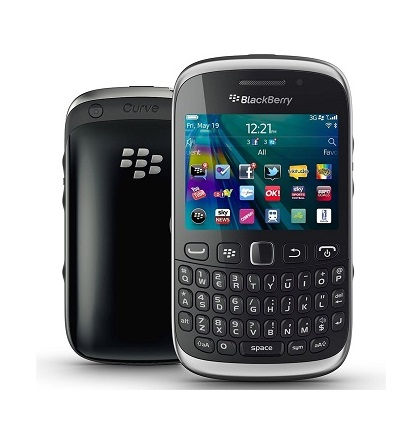
Why Blackberry fails
There can be several reasons for the failure of the legendary smartphone brand Blackberry but we have found a few factors responsible and those are listed below:
Rise of Apple brand: Apple has brought the mobile phone revolution while they have started their journey by producing smartphones from the beginning.
1. User Experience and Touchscreen Interface
- Innovative User Interface: The iPhone introduced a revolutionary touchscreen interface that was more intuitive and user-friendly compared to BlackBerry’s physical keyboard and trackball navigation.
- App Ecosystem: Apple’s App Store, launched in 2008, provided a vast array of applications, enhancing the functionality and appeal of the iPhone. BlackBerry’s app ecosystem was less developed and offered fewer options.
2. Design and Consumer Appeal
- Sleek Design: The iPhone’s sleek, modern design appealed to a broad range of consumers. BlackBerry devices, while functional, were seen as more utilitarian and less stylish.
- Broader Market Appeal: BlackBerry initially focused on business professionals, while Apple targeted both consumers and professionals, thereby capturing a larger market.
3. Technology and Innovation
- Multimedia Capabilities: The iPhone excelled in multimedia capabilities, including superior cameras, music playback, and video streaming. BlackBerry lagged in these areas.
- Frequent Updates: Apple consistently released innovative features and updates, keeping their devices at the cutting edge of technology. BlackBerry was slower to innovate and respond to market trends.
4. Marketing and Ecosystem
- Effective Marketing: Apple’s marketing campaigns were highly effective in creating a strong brand image and consumer demand. “There’s an app for that” became a cultural catchphrase, emphasizing the versatility of the iPhone.
- Integrated Ecosystem: Apple created a seamless ecosystem with its range of products (iPhone, iPad, Mac), enhancing user experience and loyalty. BlackBerry struggled to create a comparable ecosystem.
5. Developer Support and Applications
- Developer Attraction: Apple’s App Store attracted a large number of developers due to its revenue potential and large user base. BlackBerry’s developer tools and platform were less attractive, resulting in fewer apps and lower-quality software.
6. Strategic Missteps
- Slow Response: BlackBerry was slow to recognize the importance of touchscreens and consumer-oriented features. By the time they attempted to pivot with the BlackBerry Storm and later models, Apple had already established a strong foothold.
- Software Limitations: BlackBerry’s operating system, while secure and robust for email and messaging, was not as versatile or user-friendly as Apple’s iOS.
Other affordable smartphones: from the start of 2012, several smartphone brands had come up with their unique features and affordable prices and by 2016 realme, Xiaomi, redmi, oppo, and Micromax had already captured the Asian market while they were offering more features within an affordable budget. At the same time, blackberry’s smartphones were two times more costly as compared with other brands and features were very less. In addition to this, Samsung has already captured the mid-level market with their smartphone and Realme, redmi, oppo has captured the market with low-range phones while both Apple and Samsung have captured their high-range smartphone markets.
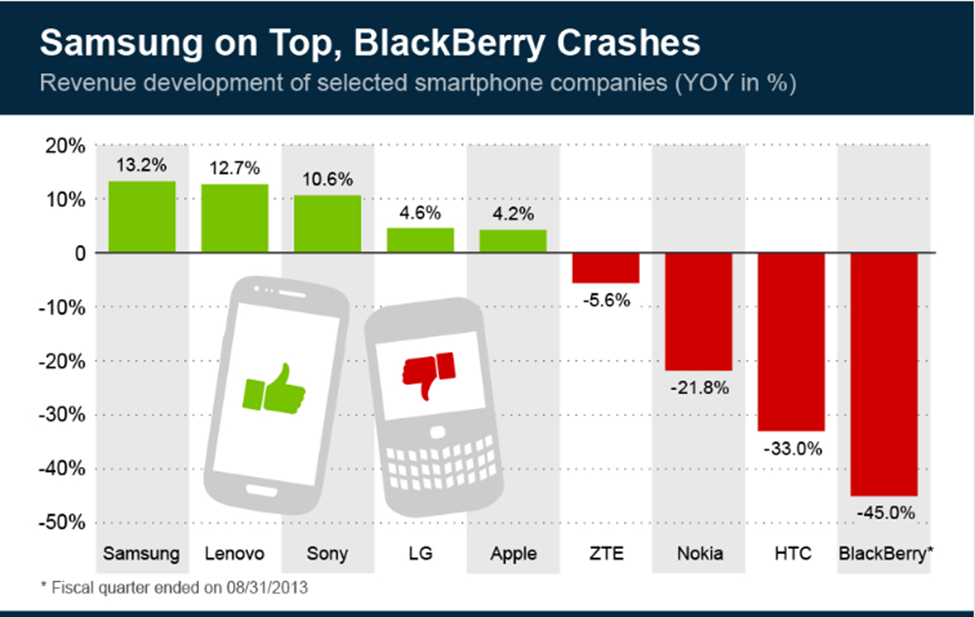
Source: Statista.com
As per the report of Statista, the global market revenue in 2013 has been published where it has been seen how Android smartphones were rapidly capturing the market and slowing down the progress of Nokia and Blackberry. At one point in time, keypad phones like Motorola, blackberry, and Nokia topped the chart in the mobile phone market. After 2010-2011, smartphone companies were about to approach with their innovative features in smartphones and the demand for keypad phones started to decrease. The above chart shows that in the 2013 August report, Samsung generated 13.2% more sales as compared with the previous quarter. Other Android smartphone companies like Lenovo and Sony have also managed to increase their sales. Apart from that, it was the start of the failure of Blackberry phones while their revenue decreased to -45% as compared with the previous quarter.
Relying on qwerty: Blackberry themselves have also relied on their qwerty keypad phones while from their starting journey, their qwerty keypad devices were a massive success in the global market and the demand for the qwerty devices was increasingly terrifying. As time goes on, several innovations come and a huge list of competitors have started their smartphone journey. Android devices have captured the smartphone market since the early 2010s while Samsung, Sony, Micromax, and One Plus began their journey from the early 2005s and before. However, then, it was quite costlier to buy an Android smartphone device. Soon after several innovations, smartphone brands like Micromax, Samsung, Xiaomi, and Nokia launched their best-feature smartphone at affordable prices. Blackberry has also brought some revolution in the smartphone market but people were demanding for the qwerty keypad phones. At this stage, the market is relying on smartphones and blackberry has no other way to launch smartphones. The main issue arises regarding the price ranges while Blackberry continues to set up its price range just like before and its competitors are offering affordable prices and more features. A huge number of Blackberry users shifted to Android because of their features and affordable price ranges. However, after the smartphone, still Blackberry devices were not sold that much like before as people were still demanding qwerty devices. Blackberry launched their smartphone privately with a physical keypad. This was one of the worst devices that Blackberry launched while the smartphone device had a smart screen while a slider was given to use the physical keypad which made the phone large to handle.
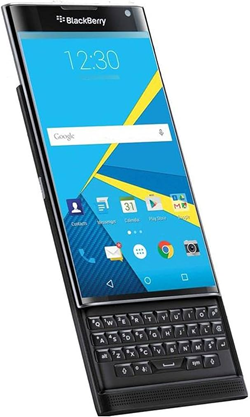
Shifting to Android: This was the greatest mistake Blackberry has ever made. There was a uniqueness in Blackberry OS which was more secure and different from Android. As time flew, blackberry devices were falling and getting huge competition from IOS and Android devices. They launched several smartphones with Blackberry OS at that time but the time was late and at that moment, Samsung, Sony, Oppo, and One Plus had already captured the Android market. Blackberry partnered with TCL corporation and handed the manufacturing process to them while it began the shifting to Android.
Price range: While all other Android devices were setting their prices at an affordable price, blackberry stuck to their high ranges and refused to drop the prices. For example, Blackberry is dependent on their range of smartphone devices offering 4GB+ 64GB forms while at the same time, other Android devices like Samsung, Sony, and Oneplus offer 6 GB+128 GB and 8GB+ 256 GB at a lesser price. Eventually, people went for cheaper devices with more features. For the range customers, were choosing Apple and Smartphones and ignoring Blackberry as they still relied on their traditional features and physical keypad. In addition to this, blackberry stopped manufacturing phones in the world and they also stopped their services and operations.
Current position of Blackberry
Blackberry has quit all operations regarding smartphones in 2022. The Canada-based company has also shut down their customer support services for smartphones. All the updates have been paused permanently in Blackberry smartphones and there is no support available for the devices. Once a market leader has a drastic fall and is removed from the market. However, still a few Blackberry smartphones are available on Amazon. Blackberry passport, keyone2 and keyone. Very few people know that the Blackberry company still exists in their Canadian region. Blackberry owners have already shut down all of their operations in 2022 and sold their company name. Till the report of 2024, Blackberry has started to work on cybersecurity, and IOT operations.
People’s demand
Blackberry has already stopped their smartphone operations in the world and their phones are no longer supporting updates. Amazon still sells Blackberry Passport, keyone, keyone 2 and sometimes Blackberry Classic. But these are the previous versions of their smartphones which do not support 5G and the latest Android updates. Blackberry Passport only supports GSM while Keynote still supports 4G LTEs. After Blackberry closed its operations, the demand for Blackberry phones started rising. People now demanding Blackberry reconsider their decision and continue their operations in the smartphone market. However, the announcement of the disfunctioning of their operations in 2020. And by 2022, they closed all of their operations and manufacturing services. But in recent cases, people started raising their wish to buy new Blackberry smartphones as some 2000 kids who have been mature now still want to buy a Blackberry phone. There are several websites which sell refurbished Blackberry smartphones but there will be no warranty and the condition. Amazon also failed to provide a warranty for keyone and keyone2. In this case, blackberry phones are still nostalgic for many people from the 2000s.

